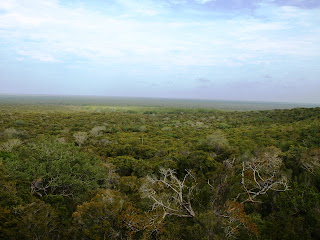 | ||
| The boardwalk at Mida Creek |
 |
| A Nature Trail in Arabuko Sokoke forest |
 |
| A vehicle track in the Forest |
 |
| An animal watering hole |
 |
| One of the community bandas situated adjacent to the forest |
Arabuko Sokoke Forest, a 42 000 hectare gazetted state forest straddling Kilifi and Malindi Forest Zones is unique in many ways and is now destined for a major promotional campaign by KFS in order to attract more visitors and put it on the world map as one of the remaining coastal dry forests in the region. The forest is home to several endangered wildlife species found nowhere else in the world. It is also the biggest such forest in the eastern coastline of Africa and hosts such other game as forest elephants, sykes monkeys among other mammals, reptiles and amphibians.
During a recent trip to determine the potential of the forest and to develop a communication plan to promote the forests, officers led by the Chief Ecotourism Officer Mr. Philip Ireri sampled the attraction of the forests and talked to various stakeholders who benefit from the forest and would like to see its sustainable development.
To the surrounding community, the forest is a source of income for thousands as community groups have formed Community Forest Associations (CFA) which are carrying out various sustainable income generating activities in the forests. Some groups have placed traps to capture the unique butterflies in the forest which they export. Others are involved in bee keeping and have been allowed to place their bee hives in the forest and as a result they have been harvesting high quality honey with a distinctive taste thanks again to the unique flowers and vegetation abundant in Arabuko Sokoke.
There are also community bandas and other eco-tourism facilities which host tourists visiting the forest. The forest encompasses Mida Creek which is occupied by various species of the mangrove and also the site of a 250 meters community owned boardwalk that meanders through think mangrove foliage.
Some community members with indigenous knowledge of the forest and tour guiding skills have also formed a tour guides association with offers guiding services to tourists in the forest. On such member is Mr. Johnson Kafulo who says that the potential of the forest has not been fully harnessed as it offers attractions that cannot be found elsewhere in the world adding that the forest has been identified as an Important Bird Area (IBA).
According to the Malindi Forest Zone Manager Mr. Bernard Orinda, the forest is a bird watchers paradise with over 235 bird species having been sighted in the forest. Among the endangered and endemic bird species found in the forest include the Spotted Ground Thrush, the Clarkes Weaver Bird and the East Coast Akalat. Others are the Amani Sunbird, the Sokoke Scopes Owl and the Sokoke Pipit.
The forest is also hope to other endemic animals like the Arders Dwika, Sokoke Bushtail Mangoose and the Golden Ramped Elephant Shrew as a well as endemic species including the Ornate Tree Frog and the Batany Dwarf Toad.
The according to Mr. Ireri, KFS in partnership with various development partners is set to improve facilities including infrastructure in the forest. This he said will add value to the forest and place it at a vantage position in as far as tourism is concerned thus generating much needed income for conservation and the neighbouring community.
Story by Leakey Sonkoyo, Corporate Communications Officer, KFS

No comments:
Post a Comment